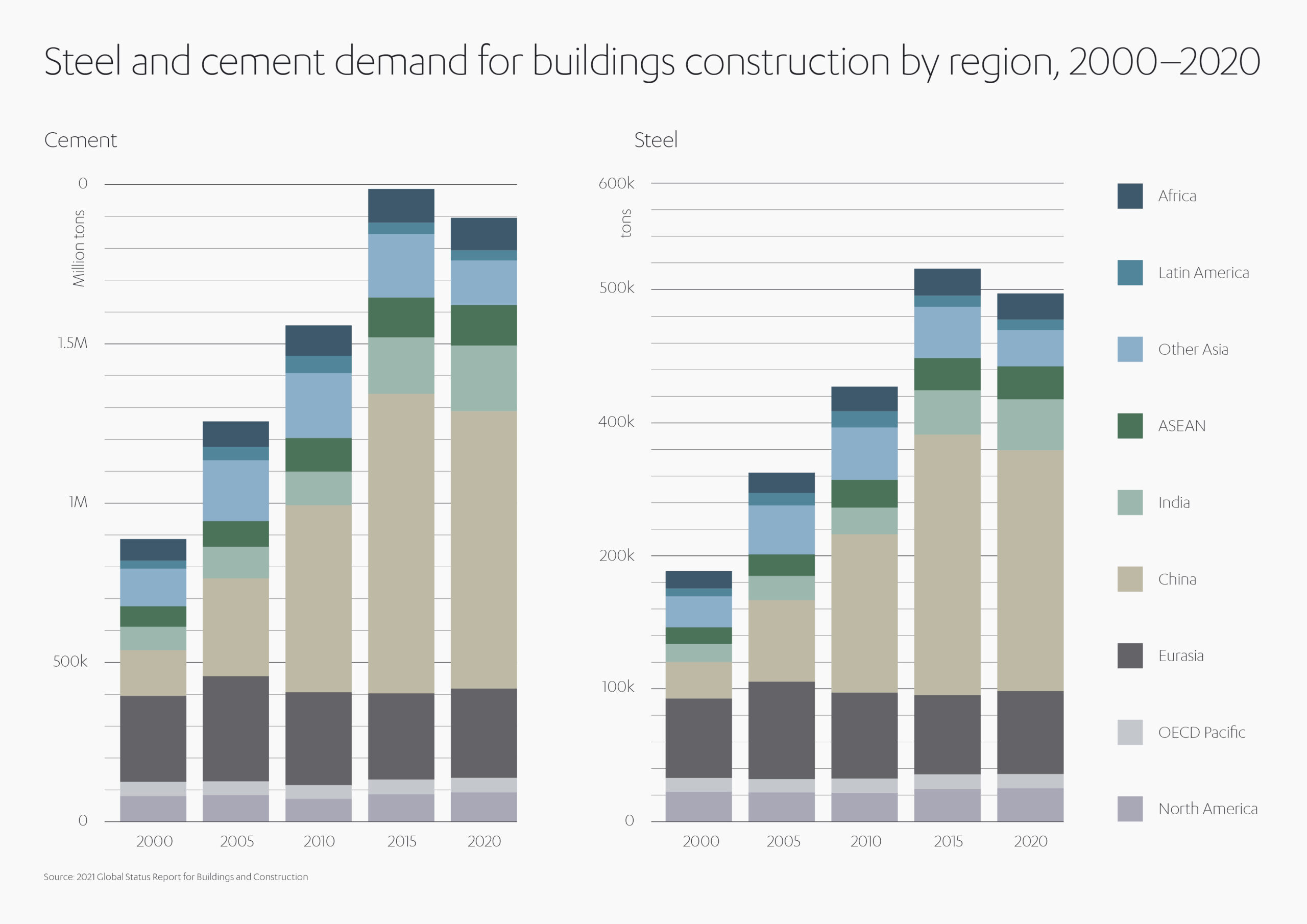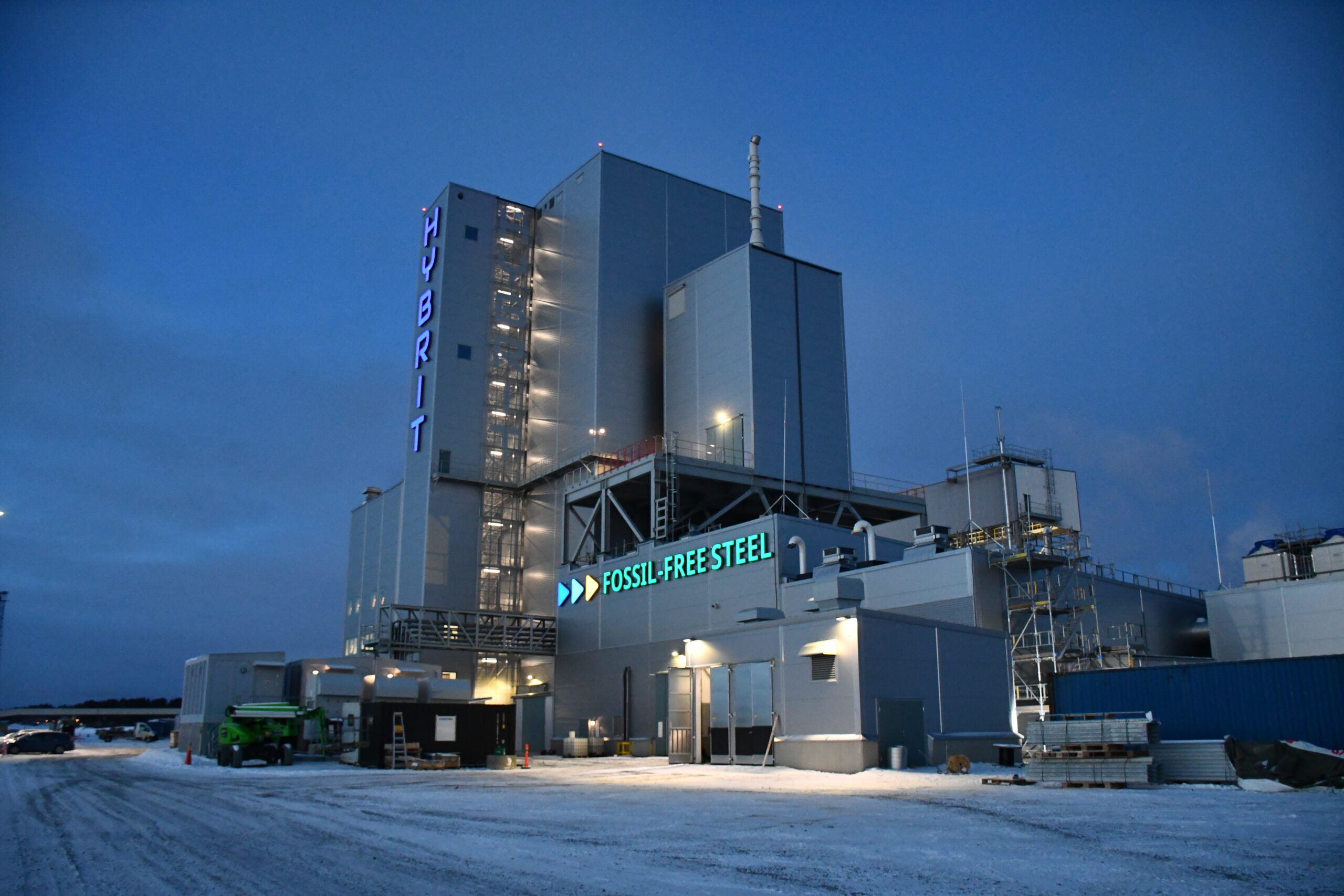Green building towards net zero
Since the 1980s, ‘Green Building’ has moved from being what some critics saw as a token gesture towards environmental concerns, to being a fundamental guiding principle for the construction industry. The reason behind this transformation? Self-preservation: Green buildings preserve precious natural resources, preserve our quality of life and, most importantly of all, may ultimately help preserve our planet.
The construction sector is a voracious consumer of natural resources, with half of them being non-renewable.
 According to the World Watch Institute, the industry consumes 40% of the world’s usage in raw stones, gravel and sand and 25% of its virgin wood every year[1]. The latest figures also show that it contributes to 23% of air pollution, 40% of drinking water pollution, and 50% of landfill wastes[2].
According to the World Watch Institute, the industry consumes 40% of the world’s usage in raw stones, gravel and sand and 25% of its virgin wood every year[1]. The latest figures also show that it contributes to 23% of air pollution, 40% of drinking water pollution, and 50% of landfill wastes[2].
But it is not just the material that construction consumes – it is also the built environment that it creates.
Internally, poorly considered construction causes health problems for residents and workers. ‘Sick Building Syndrome’ in offices, for instance, causes absenteeism and low productivity through inadequate heating and ventilation[3] and lack of natural light. Externally, factors such as natural light and air quality are a major concern in planning green cities and districts because these affect not just ‘the quality of life’ but life itself. Poor air quality, for example, is cited as increasing the risk of angina[4] and up to 36,000 deaths a year in the UK alone are linked to air pollution.[5]
Yet the harm done by existing construction practices goes beyond even this, threatening the planet itself through high levels of carbon emissions – the principal cause of man-made climate change. The Earth will reach and surpass the critical 1.5°C benchmark by 2052, if the current rate of warming does not slow down, according to the latest report from the Intergovernmental Panel on Climate Change (IPCC)[6].
The report also states that warming is a direct result of emissions generated by humans and 38% of those energy-related emissions come from buildings – 28% from operational emissions and 10% from materials and construction[7]. The target set at COP26, the 2021 UN Climate Change Conference, is to halve global emissions by 2030 and achieve Net Zero carbon emissions by 2050[8]. These targets cannot be achieved without the construction sector radically changing its practices.

The concept of green building does not, in itself, specify a particular form of construction. Any building can be a green building, whether it is a home, an office, a school, a hospital, a community center, or any other type of structure. And there will be differences between countries and regions due to factors such as climate and culture plus varying environmental, economic and social priorities.
Instead, the definition of a green building describes the principle behind its construction. A ‘green’ building is a building that, in its design, construction or operation, minimizes or eliminates negative effects on the climate and natural environment and may even improve them.

This design principle means that many green buildings will share features in common, such as an efficient use of energy, water and other resources, and the use of renewable energy sources, including solar energy and air or ground source heat pumps.
A green building will be built from materials that are non-toxic, ethical and sustainable. These materials are likely to be locally sourced to avoid the carbon emissions incurred by importing goods over long distances. There will often be measures that cut pollution and waste and promote re-use and recycling.
The air quality inside a green building will be high, as the occupants’ quality of life is a prime consideration in its design, construction and operation. The design will also aim to ‘future-proof’ the building, by making it adaptable to future environmental or technological changes.
Benefits for the bottom line
Adopting a green building approach does not only make sense from an environmental perspective, but there is also a strong business case, too. Owners enjoy increased occupancy rates and lower operating costs; developers gain through higher property values; and occupiers save money on utility bills through energy and water efficiency.
A recent study in the UK[9], for example, compared 336 green-certified buildings to some 2,000 non-certified construction projects built between 2003 and 2014, matching projects on construction dates and county location. It found that the green-certified buildings rented for 13.3%-36.5% more. Similarly, World Green Building Trends[10], a US study of the global property market, reported that green buildings – whether new or renovated – command a 10% uplift in asset value over traditional buildings.
This same study also showed owners reporting significantly lower operating costs. The mean average saving for new buildings over five years was 16.9% and 14.6% for buildings that have been retrofitted. Saudi Arabia was one of the best performers in the study, with 47% of respondents reporting more value at point of sale, 34% benefiting from higher rental rates and 41% achieving higher occupancy rates.
Green building benefits have been summarized as “people, planet and profit”, making the point that many of the advantages to green workplaces and homes come down to the health and well-being of those who live and work in them.
 A US study found that the improved internal air quality of green offices contributed to reductions in perceived absenteeism and work hours affected by asthma, respiratory allergies, depression, and stress, and to self-reported improvements in productivity[11]. A survey on behalf of the US Green Building Council (USGBC) also found that green buildings “give employers a hiring edge to attract best in class talent”[12].
A US study found that the improved internal air quality of green offices contributed to reductions in perceived absenteeism and work hours affected by asthma, respiratory allergies, depression, and stress, and to self-reported improvements in productivity[11]. A survey on behalf of the US Green Building Council (USGBC) also found that green buildings “give employers a hiring edge to attract best in class talent”[12].
Green building tech
The traditional materials of the construction industry are inherently poor in terms of carbon emissions. Whether it’s cement or bricks, glass or plaster, these materials require high temperatures in their manufacture, thereby consuming massive amounts of energy and emitting substantial levels of carbon dioxide (CO2) as a result. Roughly 600kg of CO2 is released for every ton of cement produced, which is why cement manufacturing accounts for 8% of the world’s CO2 emissions[13], while one ton of newly manufactured bricks releases 258 kg of CO2 emissions[14].

There are moves to change this. The search is on for alternatives to conventional construction techniques and for smart technology to minimize energy consumption and so, by extension, carbon emissions.
One strategy is to develop green equivalents of the established building material. In the case of concrete, CO2 can be captured and pumped into concrete itself, locking it up forever[15]. This might also improve the properties of the resulting material. The injected CO2 reacts with calcium ions in the cement, producing more calcium carbonate, and potentially making the concrete able to withstand larger loads. Another answer to the quest for ‘green concrete’ is Geopolymer Cement (GPC)[16] which reduces CO2 emissions by up to 80%-90%. GPC replaces calcium and silicon in the cement mix with industrial waste materials, such as fly ash, which is then alkali activated.

‘Green steel’ has also been developed, replacing coking coal, traditionally needed for ore-based steel making, with renewable electricity and hydrogen. But this technology is in its early stages. The Swedish consortium venture between SSAB, LKAB and Wattenfall – HYBRIT (Hydrogen Breakthrough Ironmaking Technology)[17] delivered its first batch of green steel to truck-maker Volvo AB as a trial run in August 2021, but will not begin full commercial production until 2026.

Another approach is to reduce the carbon emitted in manufacturing structural components. Rammed earth brick, for instance, can be used to create dense hard walls by mixing moist earth mixture and hard substances like gravel or clay with stabilizing elements such as concrete and compacted to create dense, hard walls. The sourcing and formation process of rammed-earth bricks lessens environmental impacts, while the material can equally help stabilize the temperature of a building so that it remains cool in the summer and warm in the winter[18].
Structural timber that incorporates carbon is increasingly common as a sustainable alternative to steel and concrete. The timber is engineered with resins to produce new components such as cross-laminated timber and laminated veneer lumber that can form the structure for blocks up to nine stories high[19].
There are also technologies emerging to tackle the carbon emissions of an operating building. Cool roofs, for instance, employ reflective paints and special tiles that absorb less heat and reflect away most of the solar radiation. This cuts heat absorption and thermal emittance, enabling cool roofs to reduce temperatures by more than 28°C. The result is less need for air conditioning, leading to reduced energy use which translates into decreased cumulative greenhouse gas emissions from power plants.
Carbon emissions can also be reduced by using technology to reduce wastage. At any given time, 30%-40% on average of a commercial building will be unoccupied. By using electronic devices like motion detectors, RFID scanners and access card readers, sensors can automatically turn off lights and adjust HVAC, cooling, heating, and ventilation options when a building, section or room are unoccupied, saving up to 30% on energy bills.
One energy-saving development nearing fruition is Electronic Smart Glass (ESG), which uses tiny electric signals to change the amount of solar radiation a window reflects. ESG can be incorporated into a buildings control system, so occupiers can choose how much solar radiation to block and so cut the cost of heating, ventilating, and air conditioning.

Scaling up
For all this ingenuity and innovation, however, a single green building will only ever have a limited impact on carbon emissions. To truly make a difference to our net zero ambitions, whole districts – if not whole towns – need to be developed along green building principles.
At this scale, the positive impact of green buildings can be amplified by other environmentally conscious measures, such as sustainable mobility, waste management systems and infrastructure. A transition to zero emission mobility solutions, such as the hydrogen mobility projects being developed in Spain by FRV, part of Abdul Latif Jameel Energy, for example, could help to reduce ground level pollution and improve the public realm.
Other design elements could include permeable pavements, green space and bike lanes for transport, combined heat and power sources for street lighting, and district heating and composting to deal with waste.
City and community-scale battery energy storage systems (BESS) could ensure a consistent supply of renewable energy, 24/7, enabling green building principles to be scaled up for city development. FRV and its innovation arm FRV-X, for example, are already involved in pioneering BESS projects in the UK at Holes Bay, Dorset; Contego, West Sussex; and Clay Tye, Essex; plus a hybrid solar and BESS plant at Dalby, Queensland in Australia. FRV acquired two additional BESS projects in the UK in autumn 2022, as well as a majority stake in a BESS project in Greece.
Another Abdul Latif Jameel business, Almar Water Solutions, is showing how advanced technology can help to strengthen the quality and efficiency of water systems. Almar and recently partnered with Datakorum, an IoT specialist, to win a contract with e& Enterprise, (previously Etisalat Digital) for a smart-communication project for water and energy infrastructure in Abu Dhabi. The project aims to ensure improved efficiency for customers and contribute to the digitization of local water infrastructure, accelerating operational improvements and preparation of the smart grid.
‘Green’ cities or districts would differ, just like green buildings themselves, according to climate, custom and business case. For example, technologies for reducing water use have a much faster payback period in water scarce regions like the Middle East and Africa than in regions with more water. Similarly, a temperate city will likely have a significantly longer payback period for district-heating technologies than one in a cold climate.


This isn’t just a far-off ambition. Green communities like this are already thriving around the world. Hammarby-Sjöstad[20] in Stockholm, for example, formerly a run-down, underused industrial district, is now a thriving “eco-village.”
Its 25,000 residents benefit from a transportation system that generates 30%-40% less carbon dioxide per household than a comparable nearby district, mainly because of 40% fewer trips by private car.
It also has a wastewater-treatment system, the hot water from which is used in the local district’s heating system, and substantially lower energy costs of between 32% and to 39%.
Barriers to green building
The difficulty with developing green districts is that currently, developers pay a premium of around 10% in higher construction costs[21]. This initial cost increase deters potential investors, despite the lower long term operating costs.

Developments such as Masdar City in Abu Dhabi avoid this by combining the roles of developer and operator. Masdar City is being built by Masdar, effectively the development arm of Mubadala, Abu Dhabi’s sovereign wealth fund. The city houses one of the largest photovoltaic installations in the Middle East and is built around a huge central wind tunnel that channels a cooling breeze, so workers and residents can walk around comfortably even during summer. Masdar City’s tenants include blue-chip companies such as General Electric, Lockheed Martin, Mitsubishi Heavy Industries, Schneider Electric and Siemens. Buildings are constructed from low-carbon cement, 90% recycled aluminum and locally sourced materials, and their energy and water demands are 40% lower than average.[22]
Masdar City is constructed to meet a minimum 3-Pearl rating according to the Estidama Pearl Building Rating System. This is one of the building energy codes available to measure how green a building is, the most common being LEED (Leadership in Energy and Environmental Design) developed in the US, the UK’s BREEAM (Building Research Establishment Environmental Assessment Method) and NABERS (National Australian Built Environment Rating System).
Without a sovereign wealth fund such as Mubadala to invest in green buildings, districts and cities, then governments and international bodies may have to step in to encourage or even compel developers to shoulder the extra initial costs. And many are doing so.
The most recent ‘Global status report for buildings and construction’ in September 2021 showed that 80 countries had mandatory or voluntary building energy codes on the national or subnational level, out of which 43 countries had mandatory codes on the national level for both residential and non-residential buildings[23].
The 2018 CARICOM Regional Energy Efficiency Building Code (CREEBC) is currently being implemented throughout the Caribbean, for instance, while Morocco and Tunisia have mandatory building codes that cover the entire buildings sector. Other African countries are also introducing codes. Ghana and Nigeria have codes that cover part of the sector, while Egypt and South Africa have voluntary codes. Botswana, Burundi, Cameroon, Côte d’Ivoire, Ghana, the Gambia, Kenya, Senegal, Tanzania and Uganda – are also developing their own codes[24].
Meanwhile, despite the COVID-19 pandemic, global investment in energy efficiency in the buildings sector rose an unprecedented 11.4% in 2020 to around US$ 184 billion, up from US$ 165 billion in 2019, primarily through targeted government support in Europe. For the first time since 2015, the annual rate of growth in energy efficiency investment in the sector has exceeded 3%.
Overall, there is gradual movement towards net zero, but it does need to become – as the UN puts it – a ‘race to net zero’, with a much greater sense of urgency. Green buildings and the benefits they deliver need to become the norm, rather than an innovation. It requires a recognition that green building is the only kind of building that can deliver net zero, preserve our environment and safeguard our way of life.
[1] Hawken, P., Lovins, E and Lovins, H, Natural, Capitalism – Creating the next Industrial Revolution, Little Brown and Co., 2009 369pp.
[2] Brown MT, Bardi E. Handbook of energy evaluation. A compendium of data for energy computation issued in a series of folios. Folio #3: Energy of ecosystems. Center for Environmental Policy, Environmental Engineering Sciences, University of Florida, Gainesville; 2011.
[3] https://www.ncbi.nlm.nih.gov/pmc/articles/PMC2796751/#:~:text=The%20sick%20building%20syndrome%20(SBS,or%20cause%20can%20be%20identified.
[4] https://tinyurl.com/2vwvyjnd
[5] https://www.newscientist.com/article/2263165-landmark-ruling-says-air-pollution-contributed-to-death-of-9-year-old/
[6] The Intergovernmental Panel on Climate Change, Climate Change 2021: The Physical Science Basis, August 2021, https://www.ipcc.ch/sr15/
[7] UN Environment Programme 2020, Global Status Report for Buildings and Construction: Towards a zero-emissions, efficient and resilient buildings and construction sector, 2020, https://globalabc.org/sites/default/files/inline- files/2020%20Buildings%20GSR_FULL%20REPORT.pdf
[8] https://www.unglobalcompact.org.uk/race-to-zero/
[9] https://nbs.net/green-building-has-a-strong-business-case/
[10] https://proddrupalcontent.construction.com/s3fs-public/WorldGreen-2021-SMR-29Oct.pdf page 26 and 29.
[11] https://www.ncbi.nlm.nih.gov/pmc/articles/PMC2920980/
[12] https://www.usgbc.org/articles/employees-are-happier-healthier-and-more-productive-leed-green-buildings
[13] https://www.nature.com/articles/d41586-021-02612-5
[14] https://henninglarsen.com/en/news/archive/2017/09/28-recycled-bricks-reduces-co2-emissions-by-1-millionplus-kg/
[15] https://arstechnica.com/science/2021/07/quest-for-green-cement-draws-big-name-investors-to-300b-industry/?comments=1
[16] https://www.cbre.co.uk/insights/articles/is-green-cement-making-concrete-progress
[17] https://www.theguardian.com/science/2021/aug/19/green-steel-swedish-company-ships-first-batch-made-without-using-coal
[18] https://designbuild.nridigital.com/design_build_review_april19/the_rise_of_green_technology_in_construction
[19] https://polandweekly.com/2022/05/25/clt-wood-has-conquered-the-world-now-its-time-for-poland/
[20] https://www.mckinsey.com/capabilities/sustainability/our-insights/building-the-cities-of-the-future-with-green-districts
[21] https://www.mckinsey.com/capabilities/sustainability/our-insights/building-the-cities-of-the-future-with-green-districts
[22] https://www.cityscape-intelligence.com/architecture/why-masdar-worlds-most-sustainable-city
[23] https://globalabc.org/sites/default/files/2021-10/Buildings-GSR-2021_EXECUTIVE-SUMMARY_ENG_14-10-21%20FIN2.pdf2
[24] https://globalabc.org/sites/default/files/2021-10/Buildings-GSR-2021_EXECUTIVE-SUMMARY_ENG_14-10-21%20FIN2.pdf2





 1x
1x

 Added to press kit
Added to press kit


